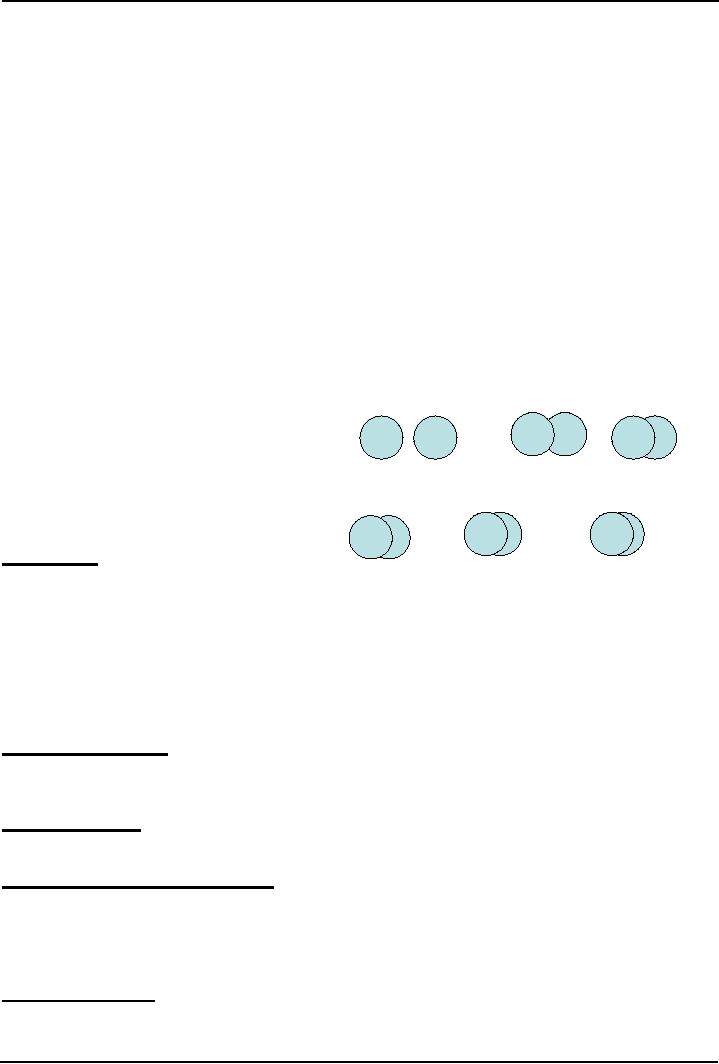 |
INTIMATE RELATIONSHIPS:Applied Social Psychology Lab |
| << INTERPERSONAL ATTRACTION (CONTINUEâ¦â¦..):Physical attractiveness |
| SOCIAL INFLUENCE:Attachment styles & Friendship, SOCIAL INTERACTIONS >> |

Social
Psychology (PSY403)
VU
Lesson
30
WHAT
IS INTIMACY?
"Intimacy
refers to sharing that which is inmost
with others"
Taken
from a Latin word intimus,
which means "inner"
or "inmost"
Arther
Aron and Elaine Eron (1997)
contend that in intimate relationships we
psychologically expand
our
self-concept
by acting as if all or some
aspects of our partner are
part of our own
selves.
William
James talked about "self as
object of attention" or self-concept. People
will think about and
respond
toward intimate ones as they
do about themselves.
"A
friend is, as it were, a second self"
Cicero, 106-43 BC, Roman
statesman
Schematic
illustration of different degrees of
self-other relatedness.
As
this link is also established in
memory, activating either
memories of the self or the other
will
automatically
activate the memories of both
persons. People will think
about and respond to intimate
others
very
similarly to how they feel
about themselves. The degree
of inclusion determines the
relationship
intimacy.
Inclusion
of others in the
self
Inclusion
of other in the self
Following
are described research
areas
where
evidence of inclusion of other in
the
self
has been found. Accordingly
intimacy
may
be manifested in:
self
Other
self
Other
Self
schemas
Other
The
attribution process
Resource
allocation
Communal
vs. exchange
relationships
Transactive
memory
self
Other
self
Other
self
Other
Self
schemas:
As
the intimacy bonds depend between
two
people,
they begin to incorporate
some of
the
other's self-schemas into
their own self
concept.
As a result of this
cognitive
blurring
of self-other distinction, people
need less time to recognize
self-descriptive traits shared
with their
partner.
For example if both partners
have self-concepts of being industrious
and tidy, while being
athletic
is
part of self concept of one
partner and hardworking is of other
partner, it will be easier
for both to
remember
their traits of industriousness and
tidiness.
The
attribution process:
Contrary
to actor
observer effect, the
attributions for the loved one
are similar to those we
would have for
our
actions
Resource
allocation:
Close
partners also share their
physical and psychological
resources with each
other.
Communal
vs. exchange relationships:
In
most of our everyday
relationships, we operate on the principle
of exchange that
whether we should
maintain
the relationship or not. The
communal
relationships, on the
other hand, are organized
according to
the
principle that people are to
be given what they need.
With loved ones we do not
think about reward
and
cost,
as if we are managing our
bank accounts.
Transactive
memory:
People
in intimate relationships have a shared
memory system for encoding,
storing, and
retrieving
information
that is greater than either of
their individual memories. For
example, in marital partnership,
one
remembers
place and organization of documents,
while other remembers the
organization of grocery items.
122

Social
Psychology (PSY403)
VU
Both
can update each other on
what is in each other's
knowledge area, and can
further embellish
their
transactive
memory.
Attachment
as an adaptive response
Attachment
theories suggest that the tendency to
form relationships is at least
partly biologically
based.
Human
infants have an infant attachment
response observable within minutes of
birth by:
The
rooting instinct (sucking
mother's breast)
The
Moro reflex (ability to
grasp and hold)
Within
days:
Newborns
recognize and prefer face, voice, and
smell of their mother
Spontaneously
imitate their caretaker's facial
expressions
Mothers
produce oxytocin hormone which influences
parenting behavior. Research
shows that during
labour
and breast feeding higher
levels of oxytocin is related
with desire for
companionship and taking
good
care of their infants
(Maestripieri, 2002).
John
Bowlby (1969)
British
psychiatrist John Bowlby (1969)
was one of the first social
scientists to systematically study
the
attachment
process. He studied human and other
species' infants and indicated
that the purpose of
attachment
is to protect immature and highly
vulnerable young
ones.
He
proposed that attachment is a part of
many species' genetic
heritage
There
is a standard pattern of three responses
produced by infants of many
species:
Protest:
Following parental separation, infants
scream and cry to get the attention, and
thus fed and
protected.
Despair:
No success in getting an access to
their parents results into
despair which reduces the likelihood
of
attracting
the attention of predators in the case of
animals.
Detachment:
if left unattended for long periods,
begin to behave independently
Parent-child
attachment
It
is considered a cornerstone for all
relationships in a child's life.
Not unique to human beings but is
found
in
most species of birds and
mammals.
The
strong emotional bond that develops
between infants and their caregivers is
known as attachment.
Attachment
means that an infant
responds positively to specific
others, feels better when
they are close, and
seeks
them out when
frightened.
Attachment
styles & later adult
relationships
Although
our biological heritage
propels us toward our
caregiver, the principle of reinforcement
theory
suggests
that the caregiver's response
will determine the strength of this
desire to establish this
proximity.
Mary
Ainsworth (1978), one of
Bowlby's associates, identified
two major attachment styles
Secure:
People
with such attachment styles think
that they are worthy of
others' love;. Moreover they
think
that
people can be trusted. Parents of
such children are nurturing
and sensitive to children's needs.
Insecure:
People
with insecure attachment style
think that they are
unworthy of love, and other
people can
not
be relied upon. Their
parents are usually
inattentive to their
needs.
As
infants interact with their
parents, they develop either
optimistic or pessimistic beliefs about
human
relationships
(Moss et al., 2004)
Through
childhood, insecurely attached
children exhibit less social
competence and lower levels
of self-
esteem
and self-concept complexity
123

Social
Psychology (PSY403)
VU
Exhibiting
vacillating pattern of approach-avoidance
(indecisive: sometimes initiating social
contact, and
sometimes
avoiding social advances) invites social
rejection confirming child's
insecurity and distrust
Many
theorists believe that infant attachment
to caregivers provides a "working model"
for adult
relationships.
Hence, there is some evidence for
continuity. However, attachment style
may change if a
person
has a significant attachment-related
event (e.g., divorce, abuse,
etc.)
Attachment
styles and culture
Although
a universal feature, the nature of attachment styles
is shaped by culture. These
differences are due
to
different views about how to
raise children, promoting independence or
otherwise. For example,
in
individualistic
cultures, parents discourage their
children from staying near
and are more likely to
give
them
toys rather than picking them
up. One study reported
that American and German children
are more
likely
to develop an insecure attachment style
than those of Japanese
(Cole, 1992).
New
concepts in attachment
styles
An
additional discovery was
that attachment styles are being
determined by two basic
attitudes:
The
extent to which one's self
esteem is positive or
negative
The
extent to which one perceives
others trustworthy
This
new conception of attachment yields
four kinds of attachment styles:
Secure:
characterized
by trust, a lack of concern with
being abandoned, and a feeling of being
valued &
well
liked
Preoccupied:
characterized
by trust, but combined with a
feeling of being unworthy of
others' love and a
fear
of abandonment
Dismissing-avoidant:
characterized
by low trust and avoidance of intimacy
combined with high
self-
esteem
and compulsive
self-reliance
Fearful-avoidant:
characterized by low trust and avoidance
of intimacy, combined with a
feeling of being
unworthy
of others' love and a fear
of rejection
Research
on attachment styles
High
interpersonal trust
Securely
attached report positive
family
(low
avoidance)
relationships
when young, while
the
Secure
Preoccupied
insecurely
attached rate their childhood
family
environment
as emotionally cold and
openly
conflicted
(Klohnen & Bera, 1998)
High
S.esteem
Low
S.esteem
Securely
attached adults easily become
close
(low
anxiety)
to
others, expect intimate relationships
to
(high
anxiety)
endure,
and handle relationship
conflicts
constructively
(Morrison et al.,
1997)
Dismissing
Fearful
If
securely attached are involved
with insecure
Avoidant
ones,
there is prototype mismatch, but
secure
avoidant
Low
interpersonal trust
partner
can buffer the negative effects
and
(high
avoidance)
may
gradually change the insecure and
make
him
change his feelings of
intimacy and self-
worth
(Feeney, 2003)
Reading
·
Franzoi,
S. (2003). Social
Psychology. Boston:
McGraw-Hill. Chapter 12.
124
Table of Contents:
- INTRODUCTION TO SOCIAL PSYCHOLOGY:Readings, Main Elements of Definitions
- INTRODUCTION TO SOCIAL PSYCHOLOGY:Social Psychology and Sociology
- CONDUCTING RESEARCH IN SOCIAL PSYCHOLOGY:Scientific Method
- CONDUCTING RESEARCH IN SOCIAL PSYCHOLOGY:Evaluate Ethics
- CONDUCTING RESEARCH IN SOCIAL PSYCHOLOGY RESEARCH PROCESS, DESIGNS AND METHODS (CONTINUED)
- CONDUCTING RESEARCH IN SOCIAL PSYCHOLOGY OBSERVATIONAL METHOD
- CONDUCTING RESEARCH IN SOCIAL PSYCHOLOGY CORRELATIONAL METHOD:
- CONDUCTING RESEARCH IN SOCIAL PSYCHOLOGY EXPERIMENTAL METHOD
- THE SELF:Meta Analysis, THE INTERNET, BRAIN-IMAGING TECHNIQUES
- THE SELF (CONTINUED):Development of Self awareness, SELF REGULATION
- THE SELF (CONTINUEâ¦â¦.):Journal Activity, POSSIBLE HISTORICAL EFFECTS
- THE SELF (CONTINUEâ¦â¦â¦.):SELF-SCHEMAS, SELF-COMPLEXITY
- PERSON PERCEPTION:Impression Formation, Facial Expressions
- PERSON PERCEPTION (CONTINUEâ¦..):GENDER SOCIALIZATION, Integrating Impressions
- PERSON PERCEPTION: WHEN PERSON PERCEPTION IS MOST CHALLENGING
- ATTRIBUTION:The locus of causality, Stability & Controllability
- ATTRIBUTION ERRORS:Biases in Attribution, Cultural differences
- SOCIAL COGNITION:We are categorizing creatures, Developing Schemas
- SOCIAL COGNITION (CONTINUEâ¦â¦.):Counterfactual Thinking, Confirmation bias
- ATTITUDES:Affective component, Behavioral component, Cognitive component
- ATTITUDE FORMATION:Classical conditioning, Subliminal conditioning
- ATTITUDE AND BEHAVIOR:Theory of planned behavior, Attitude strength
- ATTITUDE CHANGE:Factors affecting dissonance, Likeability
- ATTITUDE CHANGE (CONTINUEâ¦â¦â¦.):Attitudinal Inoculation, Audience Variables
- PREJUDICE AND DISCRIMINATION:Activity on Cognitive Dissonance, Categorization
- PREJUDICE AND DISCRIMINATION (CONTINUEâ¦â¦â¦.):Religion, Stereotype threat
- REDUCING PREJUDICE AND DISCRIMINATION:The contact hypothesis
- INTERPERSONAL ATTRACTION:Reasons for affiliation, Theory of Social exchange
- INTERPERSONAL ATTRACTION (CONTINUEâ¦â¦..):Physical attractiveness
- INTIMATE RELATIONSHIPS:Applied Social Psychology Lab
- SOCIAL INFLUENCE:Attachment styles & Friendship, SOCIAL INTERACTIONS
- SOCIAL INFLUENCE (CONTINEâ¦â¦â¦):Normative influence, Informational influence
- SOCIAL INFLUENCE (CONTINUEâ¦â¦):Crimes of Obedience, Predictions
- AGGRESSION:Identifying Aggression, Instrumental aggression
- AGGRESSION (CONTINUEâ¦â¦):The Cognitive-Neo-associationist Model
- REDUCING AGGRESSION:Punishment, Incompatible response strategy
- PROSOCIAL BEHAVIOR:Types of Helping, Reciprocal helping, Norm of responsibility
- PROSOCIAL BEHAVIOR (CONTINUEâ¦â¦â¦):Bystander Intervention, Diffusion of responsibility
- GROUP BEHAVIOR:Applied Social Psychology Lab, Basic Features of Groups
- GROUP BEHAVIOR (CONTINUEâ¦â¦â¦â¦):Social Loafing, Deindividuation
- up Decision GROUP BEHAVIOR (CONTINUEâ¦â¦â¦.):GroProcess, Group Polarization
- INTERPERSONAL POWER: LEADERSHIP, The Situational Perspective, Information power
- SOCIAL PSYCHOLOGY APPLIED: SOCIAL PSYCHOLOGY IN COURT
- SOCIAL PSYCHOLOGY APPLIED: SOCIAL PSYCHOLOGY IN CLINIC
- FINAL REVIEW:Social Psychology and related fields, History, Social cognition